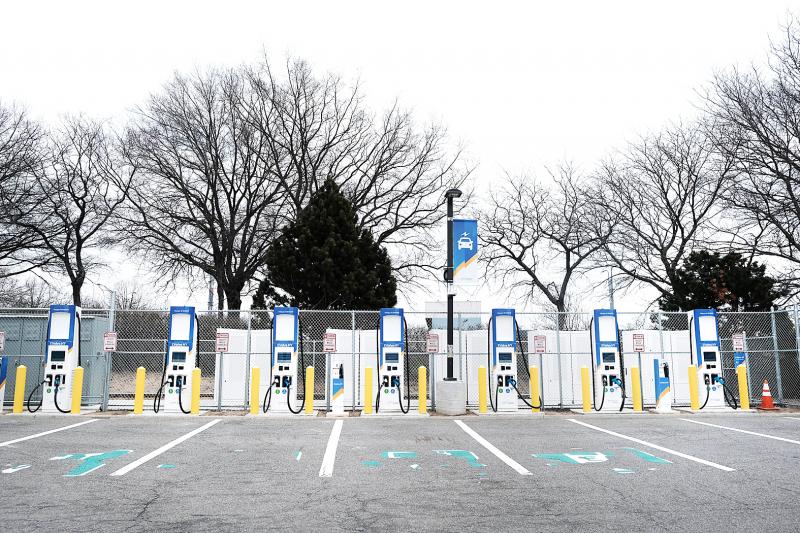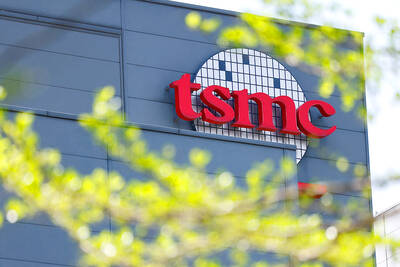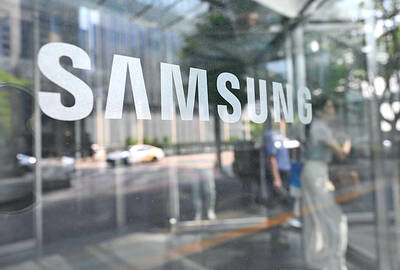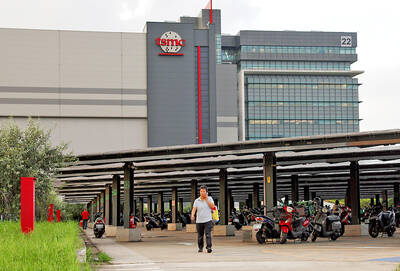US President Joe Biden’s plan to wean US drivers off fossil fuels requires massive investment in public charging stations to power the electric-vehicle (EV) revolution. So far, none of the companies that deploy the equipment has figured out how to make a profit.
The dilemma boils down to demand, and there is a certain chicken-and-egg quality to it: Most electric-vehicle drivers charge their cars at home, so many public charging stations get little use, but lots of people still driving gasoline-powered cars would not consider going electric until they see charging stations widely deployed, for fear that they will run out of juice on the road.
Speculators are piling into the industry, convinced that boom times are around the corner, while short sellers and other skeptics have said that some of these companies would go belly-up long before they figure out how to make money.

Photo: AFP
Biden’s plan to spend US$15 billion to help create 500,000 more public stations by 2030 is feeding the optimism, with investors flocking to EV charging companies since his election. The risk is that the early movers would get badly burned, potentially souring capital markets on the industry for years to come.
“It’s definitely going to require years of investment before they get any return,” said Chris Nelder, who has studied the economics of charging for the RMI energy research institute.
Nelder is sure that electric-vehicle charging would eventually be profitable.
However, when that tipping point will arrive is one of the biggest questions hanging over charging companies.
A decade into its existence, the industry is still hunting for a winning business model. Two of the more established names, Blink Charging Co and Beam Global, made less than US$10 million in revenue last year. That did not stop investors from sending Blink shares up more than 500 percent after Biden’s win in November last year, and while it has come well off its peak the company’s market valuation is still north of US$1.6 billion.
Beam jumped more than 300 percent, although it has lost about half its value this year.
The biggest US company, ChargePoint Holdings Inc, just went public via a special purpose acquisition company, or SPAC. Others, including EVgo Services and Volta Industries Inc, are poised to follow.
Fueling cars and trucks has always been a low-margin business, with gasoline stations making much of their money from selling snacks, coffee and cigarettes.
The business is even tougher when it comes to EVs. Unless they live in dense cities like New York or San Francisco, drivers do the vast majority of charging at home — their garage is their gas station. They use public chargers infrequently, with most vehicles offering more than enough range to complete daily errands without a topoff. The US Department of Energy has estimated that 80 percent of EV charging happens at home.
Another vexing issue is the nature of using parking spots to double as charging locations. If a customer pulls into a space in her apartment complex at 9pm and hooks up to buy a few dollars’ worth of electricity, more often than not, she would leave her car there until going to work the next day. No one else can use that charger for the next 10 hours, regardless of when her car is done charging.
Then there is the relatively small number of vehicles involved. Americans bought 259,000 new electric vehicles last year, a record according to BloombergNEF, but it is still just 2 percent of total car and truck sales.
Of those new EVs, 79 percent were made by Tesla Inc, which has its own branded network of “superchargers” that cannot be used by any other electric vehicle.
General Motors Co this week said that it signed agreements with seven charging providers to make sure its EV drivers would have places to plug in.
Tesla drivers are “close-looped into the Tesla network,” BloombergNEF analyst Ryan Fisher said. “Where is the demand to plug into these other networks? It doesn’t exist.”
The Biden administration hopes it can boost some of that demand with the proposed spending, part of its infrastructure plan now before the US Congress.
Some of the money would go toward grants and incentive programs to install chargers, according to a fact sheet from the White House, and some would go toward research into lowering the cost of the chargers themselves.
The charging companies are positioning themselves for profitability in different ways.
ChargePoint sells stations and offers various degrees of operational support, but does not get paid from the charging itself. A typical client might be a Silicon Valley company that offers its employees free charging at work as a perk. If a particular station gets little use, ChargePoint still gets paid.
“I wouldn’t want a driver as a customer, because I think I’d starve to death,” ChargePoint chief executive officer Pasquale Romano said in an interview. “There’s not a lot of money in electricity.”
Other companies, such as EVgo, own the chargers they deploy and make money each time they are used.
Meanwhile, Blink takes both approaches at once. The company prefers to own and operate as many of its stations as possible, but if a property owner wants to buy the chargers from Blink outright, that is fine, too.
The biggest priority is locking up good sites in high-demand areas, Blink chief executive officer Michael Farkas has said.
“Right now, this is a land grab,” Farkas said in an interview. “For us this is about getting as many locations as we can, and we’ll deal with profitability later.”
Volta Industries, which plans to go public in a SPAC deal this year, adds advertising to the mix. Its chargers come with 55-inch digital screens. A grocery store can place chargers in its parking lot and bombard customers with ads for specific products inside.
Beam Global offers a self-contained unit with a canopy of solar cells powering a battery and a charger. It does not require digging up the parking lot to install a power line.
“You can tell the world you’re driving on sunshine for free,” chief executive officer Desmond Wheatley said in an interview.
There is good reason for Beam to focus on easy installation and self-generated power. The time and cost to install a grid-connected charging station can be significant, often involving construction permits and hooking up to the local utility.
The equipment itself can range from less than US$2,000 for a slower, basic charger to more than US$100,000 for the most powerful models, according to BloombergNEF.
Increased production should bring down the hardware costs, but for now, they are another reason some of the companies struggle to turn a profit.
“It’s still early days,” said Colin Rusch, a senior analyst who covers the industry for Oppenheimer & Co. “Like with any early stage industry, you’ve got to give it some time, until they get to scale.”

TECH TITAN: Pandemic-era demand for semiconductors turbocharged the nation’s GDP per capita to surpass South Korea’s, but it still remains half that of Singapore Taiwan is set to surpass South Korea this year in terms of wealth for the first time in more than two decades, marking a shift in Asia’s economic ranks made possible by the ascent of Taiwan Semiconductor Manufacturing Co (TSMC, 台積電). According to the latest forecasts released on Thursday by the central bank, Taiwan’s GDP is expected to expand 4.55 percent this year, a further upward revision from the 4.45 percent estimate made by the statistics bureau last month. The growth trajectory puts Taiwan on track to exceed South Korea’s GDP per capita — a key measure of living standards — a

Samsung Electronics Co shares jumped 4.47 percent yesterday after reports it has won approval from Nvidia Corp for the use of advanced high-bandwidth memory (HBM) chips, which marks a breakthrough for the South Korean technology leader. The stock closed at 83,500 won in Seoul, the highest since July 31 last year. Yesterday’s gain comes after local media, including the Korea Economic Daily, reported that Samsung’s 12-layer HBM3E product recently passed Nvidia’s qualification tests. That clears the components for use in the artificial intelligence (AI) accelerators essential to the training of AI models from ChatGPT to DeepSeek (深度求索), and finally allows Samsung

READY TO HELP: Should TSMC require assistance, the government would fully cooperate in helping to speed up the establishment of the Chiayi plant, an official said Taiwan Semiconductor Manufacturing Co (TSMC, 台積電) yesterday said its investment plans in Taiwan are “unchanged” amid speculation that the chipmaker might have suspended construction work on its second chip packaging plant in Chiayi County and plans to move equipment arranged for the plant to the US. The Chinese-language Economic Daily News reported earlier yesterday that TSMC had halted the construction of the chip packaging plant, which was scheduled to be completed next year and begin mass production in 2028. TSMC did not directly address whether construction of the plant had halted, but said its investment plans in Taiwan remain “unchanged.” The chipmaker started

MORTGAGE WORRIES: About 34% of respondents to a survey said they would approach multiple lenders to pay for a home, while 29.2% said they would ask family for help New housing projects in Taiwan’s six special municipalities, as well as Hsinchu city and county, are projected to total NT$710.65 billion (US$23.61 billion) in the upcoming fall sales season, a record 30 percent decrease from a year earlier, as tighter mortgage rules prompt developers to pull back, property listing platform 591.com (591新建案) said yesterday. The number of projects has also fallen to 312, a more than 20 percent decrease year-on-year, underscoring weakening sentiment and momentum amid lingering policy and financing headwinds. New Taipei City and Taoyuan bucked the downturn in project value, while Taipei, Hsinchu city and county, Taichung, Tainan and Kaohsiung